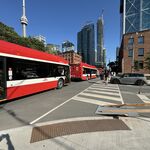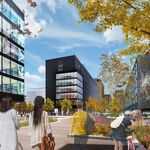Juan_Lennon416
Senior Member
Umm... no, Sheppard East can't "easily" do with BRT.
Says you. You really need to get off the LRT for Sheppard East or nothing attitude
Umm... no, Sheppard East can't "easily" do with BRT.
Says you. You really need to get off the LRT for Sheppard East or nothing attitude
Which Option A are you talking about?
Wasn't Option A ending the subway at York University, and then going north with LRT? Aren't we building Option B?The new option A.
Umm... no, Sheppard East can't "easily" do with BRT.
The Sheppard-Finch LRT Benefits Case has the maximum loading point of the Sheppard LRT at 5,300 passengers per hour per direction. To help you better visualize that, it would require an LRV train of approximately 62 metres in length (two thirds the length of the trains on the Sheppard Subway; double the length of our new streetcars) arriving once every 3 minutes (same frequency as Line 1 & Line 2 during rush hour) to accommodate that ridership.
To move that same amount of people on a BRT, you'd need to have one of the TTC's new articulated busses arriving once every 50 seconds in both directions. The size of the bus fleet would have to be 3.3 times greater than the LRT. The operational and maintenance costs of that would be enormous, and would be a logistical nightmare to have transit signal priority working reliably (causing travel delays) with one bus passing through an intersection every 25 seconds. The thing would need to be replaced with a light rail solution on day one.
The new option A. I will say that I'm not really pro opening a new debate in transit... we will just waste more time. the only thing I'm OK with is going back to the transit city art conversion because we really have no idea how much the subway will cost or how long it will take to build.
No, it's not what I say. It's what the facts say. Please do tell us how you'd move 5,300 people an hour on a BRT system.
This compares to a maximum loading point of 5,300 persons for the 13.5 KM SELRT and 3,400 for the 11 km FWLRT.
We are talking Sheppard. Sheppard is more like 3,000 pphpd.
http://www.metrolinx.com/en/docs/pd...25/torontotransit_boardreport_25april2012.pdf
And I think Finch is more like 2,800 [same source].
The 190 rocket is BRT. It's not full all the time.
We are talking Sheppard. Sheppard is more like 3,000 pphpd.
http://www.metrolinx.com/en/docs/pd...25/torontotransit_boardreport_25april2012.pdf
I view BRT as essentially LRT without the rail.
You can, but it has to be fully grade separation with high speed limit. Since any LRT/BRT in Toronto will not be fully grade separated and low speed limit, ridership will be lower with LRT being the best option in the long run.No, it's not what I say. It's what the facts say. Please do tell us how you'd move 5,300 people an hour on a BRT system.
3,100 pphpd was the figure used in the Backgrounder for the Big Move as well. Well within the range of BRT, especially if the Scarborough Subway and/or GO REX on the Stouffville line are built. It would greatly increase the turnover rate along the route, lowering the peak point ridership.
If they're both in dedicated lanes on-street, then yes. BRT is essentially LRT without the tracks, and is more efficient low end when it comes to ridership (in the 1,000-2,000 pphpd range). However, it's less economical as you get up into the 4,000-5,000 pphpd range.
The capital costs of implementing BRT are lower than for LRT, roughly $10 million per kilometre in contrast to approximately $40 million for LRT. However, ongoing operating and maintenance costs are dependent on the number of passengers per kilometre and the frequency of service. BRT is cheaper than LRT to operate and maintain only until a peak passenger per hour threshold is reached, which is less than 2000 riders per hour. With an anticipated ridership in excess of this threshold, operations and maintenance for LRT in the Etobicoke-Finch West corridor is anticipated to be cheaper than BRT.
Okay lets say 3,100 pphpd for arguments sake.
3000 is on the edge of BRT's useful range. The problem with BRT is that it costs far more than LRT to operate if you're moving more than 2,000 pphpd. So while BRT can physically move 3,000 pphpd, it's not the best value for money. So regardless of if Sheppard East is moving 5,000 or 3,000 pphpd, LRT is still the superior option.
See the Finch West LRT EA:
Finch West LRT Environmental Assessment (Page 2-2)




